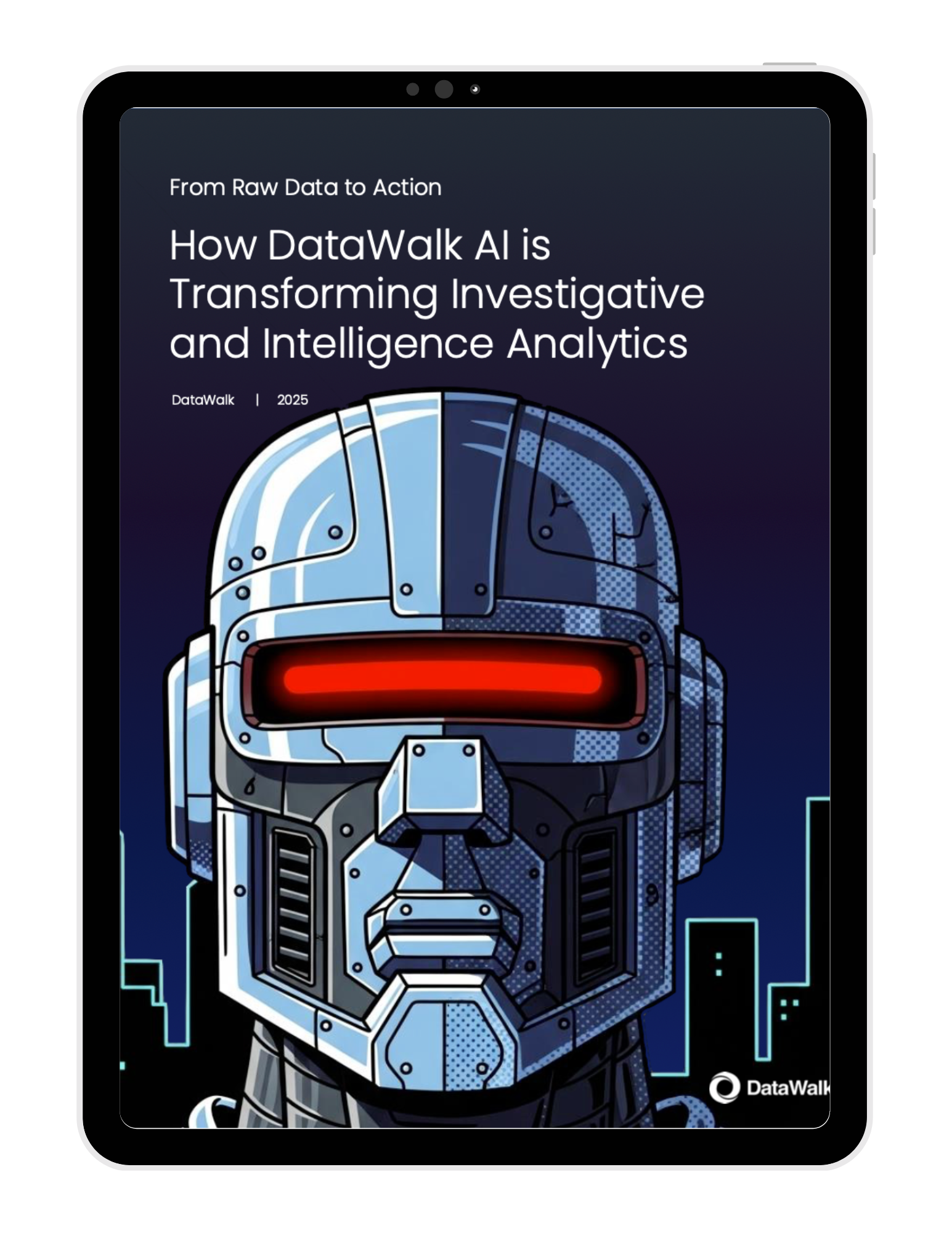
Transforming Data into Actionable Intelligence with DataWalk's Unified AI Platform
DataWalk's AI-powered platform transforms complex, disconnected data into operational intelligence through a structured, three-stage process:
- Source to Knowledge
- Knowledge to Insight
- Insight to Decision
By unifying knowledge graphs, machine learning, and generative AI within a single cohesive architecture, organizations can convert raw data into actionable insights, accelerating decision-making and dramatically improving investigative outcomes.
How does AI transform raw data into operational knowledge?
The first stage, Source to Knowledge, addresses the core challenge of converting disparate data sources into a coherent, contextualized whole.
Organizations often possess data in various formats-from structured databases to unstructured documents, CSV files, and web pages. A common pitfall is simply indexing this data for keyword search, which strips away critical context and relationships, creating more noise than knowledge.
DataWalk solves this with a model-driven, ontology-first approach. The platform automatically converts both structured data and ad-hoc inputs into an integrated, operational knowledge graph. This process preserves the full context of the data, eliminating the need for manual modeling or hard-coded logic.
Customer Example
For example, an intelligence agency using DataWalk automated the conversion of text files and open-source data into a knowledge graph, reducing data preparation time from weeks to minutes while retaining full traceability.
Similarly, a US bank analyzing the Pandora Papers used DataWalk's AI and NLP capabilities to process articles, extract entities, and perform deduplication in a few hours-a task that was estimated to require six months of manual effort.
How can analysts uncover hidden insights from structured knowledge?
Once data is structured in a knowledge graph, the second stage, Knowledge to Insight, focuses on rapid, accessible discovery.
The goal is to empower analysts to find hidden patterns and networks without needing to be a programmer. DataWalk's investigation software provides a suite of powerful, no-code tools to achieve this.
Analysts can run multi-hop graph queries, use graph algorithms like "Find All Paths" to instantly visualize connections across billions of objects, and deploy no-code pattern recognition to detect known criminal typologies. This is augmented with advanced AI and machine learning capabilities like anomaly detection, graph embeddings, and community detection to uncover non-obvious links.
Customer Example
For instance, a North American law enforcement agency uses these features to analyze billions of phone connections, accelerating investigation time by more than 75 times.
Another bank applied graph embeddings to reclassify over 1,000 accounts from low to high risk by identifying shared behavioral patterns that were not directly linked.

What makes DataWalk's unified AI platform effective?
DataWalk delivers breakthrough results by combining critical capabilities into a unified platform.
The system integrates an ontology-first data model, a powerful inference engine, machine learning, and seamless connectivity with Generative AI and LLMs. This cohesive architecture empowers organizations to move efficiently through the entire analytical lifecycle, from raw data to confident action.
By remaining open and interoperable, the platform ensures that the intelligence generated does not remain siloed. Instead, it orchestrates processes that extend across systems, guaranteeing that decisions flow directly into real-world operations and deliver measurable impact.
FAQ
A knowledge graph is an intelligent data model that organizes information as a network of real-world entities (like people, organizations, and events) and the relationships between them. This preserves critical context that is often lost in traditional databases or spreadsheets.
DataWalk uses AI-powered Natural Language Processing (NLP) to automatically read unstructured text, identify key entities (people, places, dates), and understand the relationships between them. This information is then structured and integrated into the central knowledge graph for analysis.
This is the final stage where validated insights are operationalized. It involves integrating analytical findings from DataWalk directly into an organization's existing workflows and systems, such as case management or compliance platforms, using APIs and embeddable visualizations to drive concrete action.
DataWalk uses advanced techniques like multi-hop pathfinding and machine learning algorithms like Graph Embeddings. These methods can identify hidden relationships between entities that are not directly linked but share similar behaviors, characteristics, or network patterns.
LLMs are integrated to automate and accelerate the analysis of large volumes of text. They can summarize thousands of documents, detect specific themes like hate speech, extract key discussion points, and enable natural language queries, saving analysts hundreds of hours of manual work.
No, DataWalk is an open and interoperable platform. It is designed to augment and integrate with your existing technology stack, not replace it. It provides robust APIs and other mechanisms to ensure that intelligence flows seamlessly into your operational environment.
Join the next generation of data-driven investigations:
Discover how your team can turn complexity into clarity fast.

Solutions
Product
Partners
Company
Resources
Quick Links




